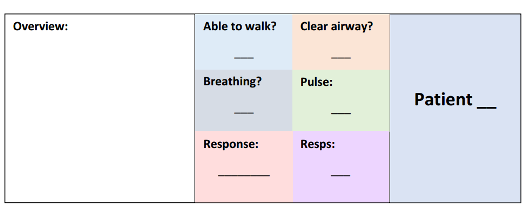_
Triage Classroom Exercise
Triage and prioritisation is carried out by us on a small scale all the time when doing pre-hospital care. This could be if we get more than one patient at a time in a first aid post or multiple
patients are injured from the same mechanism. Those with a bit more experience/training who perhaps also work on ambulances need to have an accepted structured approach to triage
when faced with a large number of casualties in a single incident. Whilst it is good to test these skills out in a large scale mock-up incident (and this will probably most accurately
put these skills to test without being the real thing) but these kind of large scenarios take a significant amount of time and resources to plan and run. This article is all about a
fairly simple classroom based exercise that tests the basic prioritisation skills for your organisation's standard structured triage sieve.
What are the challenges to learn?
There seem to be a couple of things that need to be learned or practiced when it comes to triage. The first (and perhaps most simple) of these is simply learning what observations and
patient presentation are allocated to each priority category. The aid-memoire cards that we often carry with us are a useful reminder and can also be used to help keep a count of how many
casualties are in each category. Sometimes, it is good to do something more practical to help get these numbers into our heads. The second area that can be difficult when learning to do a
good triage sieve is the fact that the sieve often prioritises things differently to what we are used to in our everyday first aid treatment. For example, if the triage sieve states that all
walking casualties are priority 3 by default, it can sometimes be difficult not to immediately treat somebody with an arm missing but is stumbling towards you - it's not what your instant reaction
is to do.
The Exercise
This activity needs you to have prepared a room full of patient dolls. Each doll is assigned a patient card that has a brief overview of the patient and a list of basic observations (you can download some
cards we have prepared below). Each person then comes into the room and needs to correctly triage each doll into the appropriate priority based on the information on each card. If they ask all those who
can walk to get up and move somewhere, the facilitator can tell them which of the patients is able to get up and walk. Given that triage should be performed quickly, it seems reasonable to time each
person so that they know how long it was taking them to triage each patient (evidently it will take slightly longer for real as the observations won't be written on a piece of card!). The
exercise therefore gets people to actively triage under a small amount of pressure and therefore begins to embed the knowledge into your mind. Adding a few patients with significant injuries but
who are actually able to walk or by adding a few non-breathing casualties you can also help people get used to the different way of approaching each individual in a large incident compared
to if they were on their own.
The Patient Cards
We've created a set of 12 patient cards that you may want to download and use or you can download the blank templates to edit yourself.
Blank Template (Word doc): Download
Blank Template (pdf): Download
12 pre-filled cards (pdf): Download
Practical Tips:
- There are some variations to the triage sort (like using capillary refill instead of pulse) so it might be worth slightly editing the cards to suit your organisation's triage sieve.
- If you have enough cards, you could run it multiple times for the same person so that they can see how they are improving and to really embed those numbers into their mind.
- This article is not covering the issue of when the triage sieve is appropriate - this will be something you will need to include in your training.
